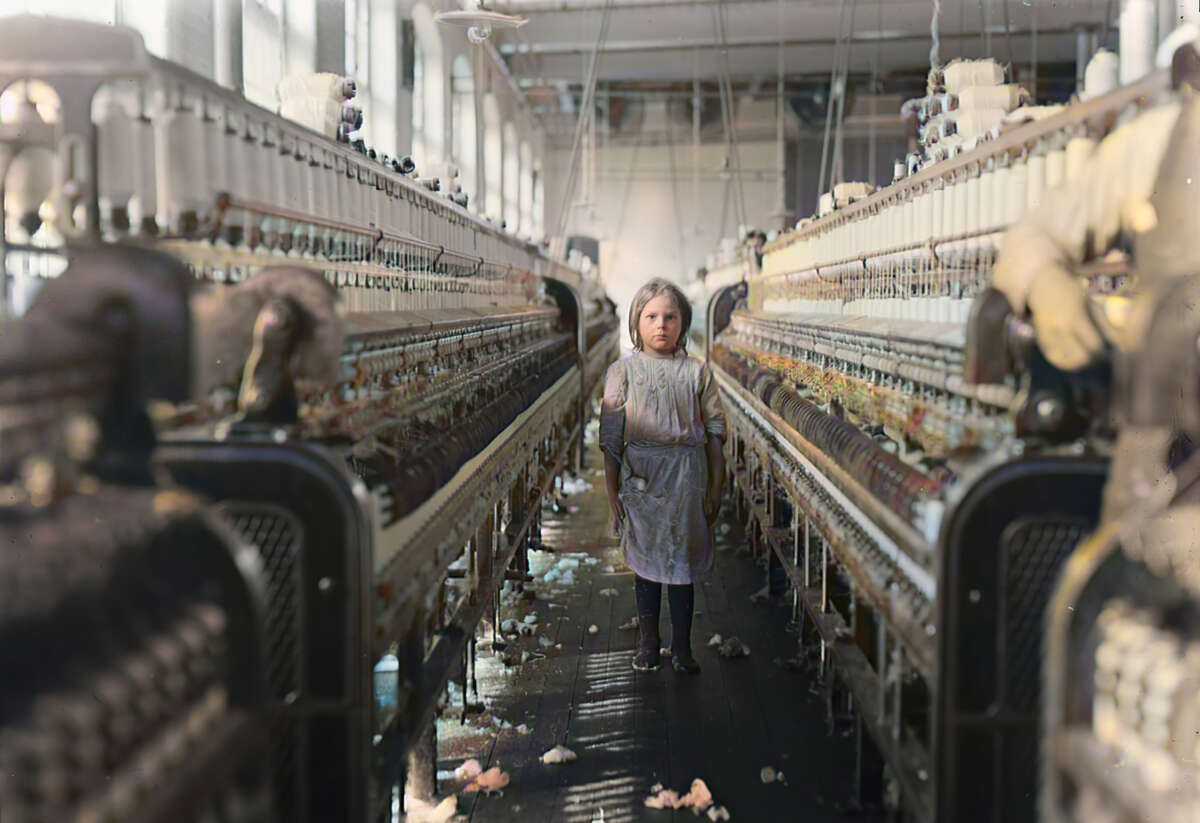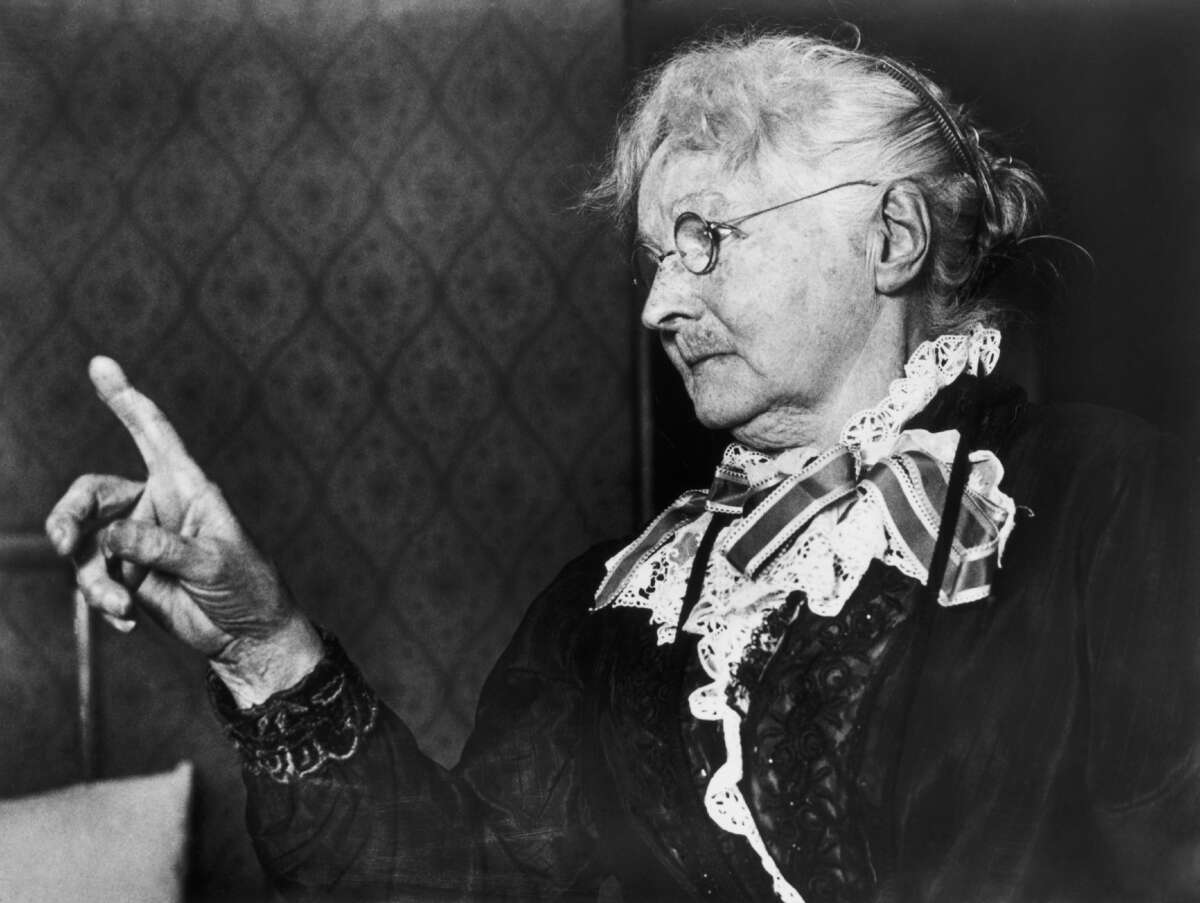Mother Jones Organized Against Child Labor 120 Years Ago: Let’s Resume Her Fight
This May Day, in a moment of resurgent child labor, let’s take time to remember and be inspired by Mother Jones.

To the shock of many, the issue of exploited child labor has been grabbing headlines in the United States In late February, The New York Times published a that documented how migrant children as young as 12 are working as roofers and food deliverers, in slaughterhouses and industrial factories, for major corporations and firms, suffering injury and even death, while authorities have .
All this comes as a barrage of states, driven by corporate lobbying and billionaire dark money, move to child labor laws. For example, Iowa’s loosening child labor regulations was virtually written by and funded by wealthy far right donors.
A big reason these developments feel so startling is because the battle against child labor at the state and federal level was — so we thought — fought and won long ago through a decades-long campaign that began in the late 19th century and ended with the passage and upholding of the .
It is an apt moment to revisit that fight against child labor: This year marks the 120th anniversary of the famed protest, the 1903 March of the Mill Children, led by the legendary labor leader, Mother Jones.
Called “the most dangerous woman in America” by West Virginia District Attorney Reese Blizzard for to “[crook] her finger” and have “20,000 contented men lay down their tools and walk out,” Mother Jones may have been the most famous woman in the U.S. during the early 20th century. An unmatched orator driven by a bottomless love for the working class, she overcame personal calamity to reinvent herself as the adored mother figure of the labor movement and as a crusader against child labor

Bills Enabling Child Labor Can Be Traced to This One Conservative Lobbying Group
The Foundation for Government Accountability has backed bills to expand child labor in at least three states.
By Sharon Zhang , TRUTHOUT
April 24, 2023
This May Day, as the injustices she fought against rear their heads once again, the history of Mother Jones — her 1903 children’s march, as well as her indomitable spirit that inspired thousands to fight — are as relevant as ever.
“She Was the Walking Wrath of God”
“She had force, she had wit, above all she had the fire of indignation — she was the walking wrath of God.” So the famed muckraker Upton Sinclair sometime after the in a fictional description of Mother Jones. By then, she was already an icon, the most notorious labor leader in the U.S.
But before she became Mother Jones, she was Mary Harris, born in Cork, Ireland, in 1837. The Great Famine drove her family to Toronto in the early 1850s. After stints as a teacher and seamstress in Chicago, Harris moved to Memphis, Tennessee, and married George Jones, a proud member of the Iron Molders Union. She soon bore four children, but disaster struck in 1867 when a epidemic ripped through Memphis. In the span of a week, Mary Jones’s entire family perished.
Mary Jones almost never mentioned this catastrophe later in life, but it drove her transformation into Mother Jones.
“This is really the most important event in her life, and of course, it’s not the sort of thing one gets over, even if you don’t talk about it,” Elliott Gorn, author of the definitive of Mother Jones, told Truthout. “I really think that was what put the emotional dynamite into her life that allows her to go out and be this fearless organizer — she had nothing left to lose.” She soon moved back to Chicago and set up a dressmaking shop. It burned down in the of 1871.
For the next 25 years, Mary Jones virtually disappeared. We know from her autobiography that she attended workers’ meetings, and joined the . Then suddenly she reemerged toward the end of the century in a new public persona, Mother Jones, defender of workers’ rights everywhere.
Clad in an ornate, black Victorian dress and hat with her fluffy white hair falling into wire-rimmed spectacles, she mesmerized throngs of miners and mill workers with a piercing voice that flouted genteel etiquette, berating them like an angry grandmother to fight.

Gorn stresses how Mother Jones intuited a reworking of dominant ideas about gender and age to create a character that gave her power and influence to serve the labor movement.
“A poor, elderly, Irish immigrant woman: that is not a place of power in American society, or even in labor unions, which are mostly very male,” said Gorn. “But the character of Mother Jones gave her a source of power: the mother of the labor movement, the fearless protector of her brood.”
She even lied about her age, claiming she was a full seven years older than she really was. “She’s increasing her venerability,” said Gorn. “She wants to be able to go to a group of tough coal miners and say, ‘If me, an old woman, can be out here risking my neck, certainly you men can be doing the same.’”
From the late 1890s through her death in 1930, Mother Jones would become a national celebrity, and, for many workers, an almost mythical figure: the matron of the family of labor; the mother of soot-covered coal miners from Pennsylvania to Colorado; the nemesis of robber barons; speaking profanities in her Irish accent, urging workers to unite across divisions of race, gender and nationality, facing down armed mine guards, enduring arrests and prison time with aplomb.
As Gorn , “The first half of Mary Jones’s life prepared her for the task of becoming Mother Jones.” She was a survivor. She was angry. She carried with her a “suppressed rage” that she channeled into the fight for justice. She wanted workers to fight.
And nothing drew her wrath more than child labor.
“Well, I’ve Got Stock in These Children”
According to the 1900 U.S. census, children under 16 years of age were employed (though that is certainly an underestimate). Then, as now, many of them were immigrants.
In 1903, nearly 75,000 textile workers struck in Philadelphia, including 10,000 children — “stooped things, round shouldered and skinny,” Mother Jones. Pennsylvania was second only to in its number of child laborers, and, according to Mother Jones, when she asked reporters why they refused to cover the issue, they responded that they couldn’t because the mills’ owners had stock in the newspapers.
“Well, I’ve got stock in these little children,” she said, “and I’ll arrange a little publicity.”
She assembled a crowd of children in the city’s historic , shouting at and shaming nearby city officials. “I held up their mutilated hands and showed them to the crowd and made the statement that Philadelphia’s mansions were built on the broken bones, the quivering hearts and drooping heads of these children,” she later . “That their little lives,” she added, “went out to make wealth for others.”
She berated local officials as they passed by, lifting up gaunt children and yelling, “Some day the workers will take possession of your city hall, and when we do, no child will be sacrificed on the altar of profit.”
Met with only shrugs, Mother Jones concocted a brilliant public relations move: She would take the mill children on a weeks-long march from Philadelphia, up through New Jersey, past New York City, and all the way to Theodore Roosevelt’s summer mansion on Oyster Bay, Long Island. They would demand to speak to the president.
Mother Jones announced the march to the public on July 7, 1903, and soon set off with around 100 children carrying placards that read “We want time to go to school” and “We want time to play.” The media following them from town to town as they stopped in cities like Trenton, New Brunswick and Princeton, where Mother Jones spoke to a large crowd gathered near the town’s storied university about “higher education.”
“Here’s a textbook on economics,” she , pointing to a “little chap” of 10 years who was “stooped over like an old man from carrying bundles of yarn that weighed 75 pounds.”
“He gets three dollars a week and his sister who is 14 gets six dollars,” she shouted. “They work in a carpet factory 10 hours a day while the children of the rich are getting their higher education.”
She lambasted not only the mill bosses but also their owners on Wall Street — the bankers and investors who were the ultimate profiteers behind child labor.
Gorn says the children’s march was a major success. “It was just a constant drumbeat of news. She just had this remarkable flair for the dramatic.” He emphasizes that while moral outrage drove Mother Jones’s hatred for child labor, it also symbolized, for her, capitalism’s cutthroat degradation of all workers.
“She understood that it’s a mistake to think of child labor as a separate category from all of labor,” he said. “One of the reasons you organize the children’s march is not just because it’s terrible exploitation of children, but because their cheap labor undercuts the work of adults.”
Mother Jones continued the march — smaller after a torrid heat wave shrunk its initial numbers — through Manhattan and Coney Island and finally, on July 28, to Oyster Bay, where Roosevelt refused to meet with them.
Nevertheless, the march was a resounding success, with the media closely covering the high drama. “She gained invaluable publicity for the issue of child labor,” Gorn.
Moreover, the march was an important early catalyst for the reform movement that, in stops and spurts in the decades to come, ultimately won regulating child labor.
“Pray for the Dead and Fight Like Hell for the Living”
After her death in 1930, Mother Jones faded softly from national memory, though not in the coal-mining communities that were her strongest base.
The award-winning actress Kaiulani Lee first learned about Mother Jones while performing in Appalachia during her tours with the NYC Street Theatre in the 1970s. She remembers visiting a miner’s cabin with an image of Jesus Christ hanging on the wall. Nearby, she saw another picture of an “old woman in Victorian garb.”
“I recognized Christ, but I didn’t know who she was,” Lee told Truthout.
Lee read Mother Jones’s autobiography and never forgot about her. Decades later, Lee decided to use her incredible writing and acting talents to bring Mother Jones back to life. “I knew hers was the voice that could speak for workers,” she said.
You can get a sense of what Mother Jones’s powerful presence must have felt like by watching Lee’s performance in the highly lauded new film, , praised by everyone from the Amazon Labor Union’s Chris Smalls to the Association of Flight Attendants’ Sara Nelson.
The 55-minute film takes place around the time of the 1921 , perhaps the most violent strike in U.S. history. Mother Jones is in a secluded cabin in the woods of West Virginia.
“There is a war between the classes,” she begins, in her faint Irish brogue. “I have been present in that war for half a century.” What follows is an acting masterpiece, a one-shot monologue, where Lee takes you through the intense drama — and unfathomable tragedy — of Mother Jones’s life, all in the labor leader’s own words. The film is tense, brilliant, emotional, and most of all, invites the viewer to join in struggle.
Lee’s Mother Jones discusses the issue of child labor and recounts the children’s march.
“Struggle and lose, struggle and win,” she says during one of the film’s dramatic crescendos. “That’s the story down the stairway of the ages.” The film captures the spirit of struggle that drove Mother Jones’s life, and by example, pleads with us to continue that struggle today.
I watched the film from beginning to end twice, and both times it left me teary-eyed and filled with fire and fight, eager to dash to any rally or picket line within reasonable distance. I hope it is in union halls, left-wing bookstores and college campuses across the country.
Others are also keeping Mother Jones’s legacy alive. During the historic 1989 Pittston coal strike, dozens of women, mostly miners’ family members, banded together as the “,” waging militant action to support the strike.
The Chicago-based holds regular events in her honor and, after years of campaigning, won permission to build a at a prime location in the Windy City.
In 2021, when striking Warrior Met Coal miners in Alabama staged a national solidarity rally, a 12-foot inflatable of Mother Jones, her fist in the air, greeted the gathering.
There’s a reason Mother Jones lives on: Through personal tragedy, she emerged as the very embodiment of labor’s struggle, a transcendent voice, mothering and thundering, that could wipe the fear and lethargy from the eyes of workers and embolden them to fight. When workers across the world today invoke her most famous slogan — “Pray for the Dead and Fight Like Hell for the Living” — they are recalling that spirit of solidarity and struggle that she embodied and tried to bestow on others.
One-hundred-and-twenty years after the iconic children’s march, with migrant kids filling factories and slaughterhouses, with our own modern-day robber barons strong-arming a rollback of child labor laws, and with thousands of workers, from coffee shops to warehouses, recreating anew labor’s militant tradition, the legacy of Mother Jones is as relevant as ever. She inspires workers today just as she did over a century ago.
No comments:
Post a Comment